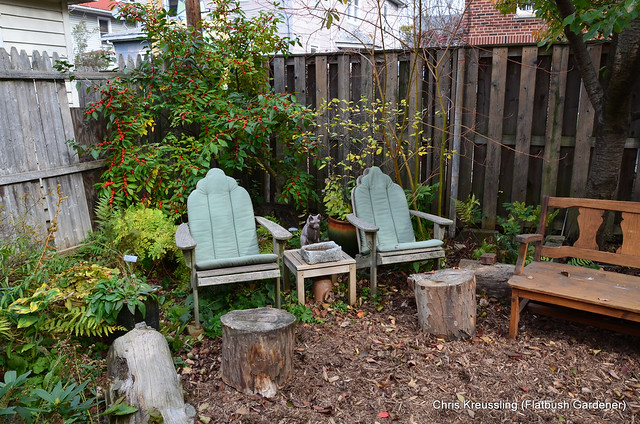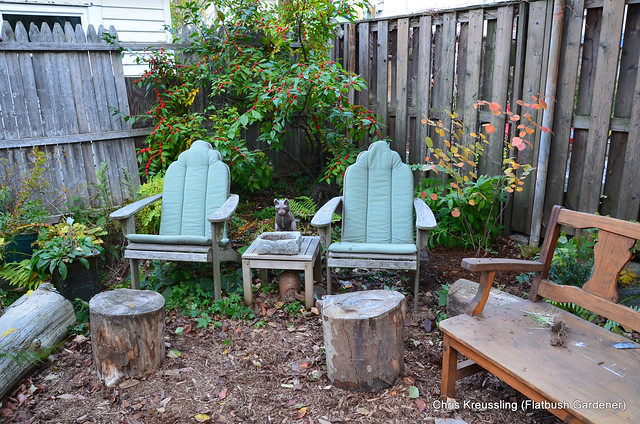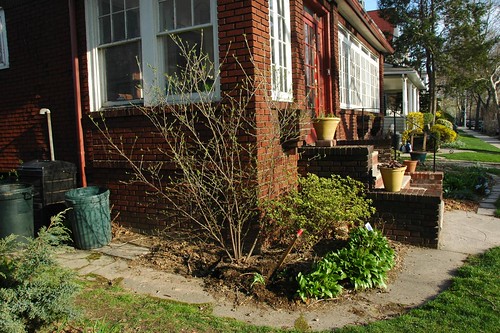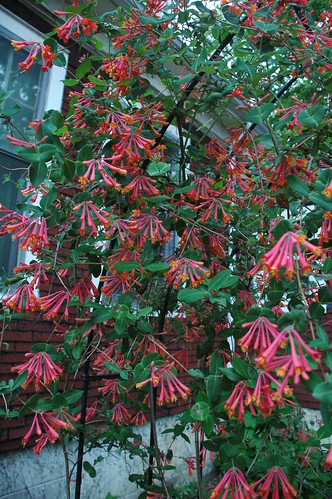Update 2014-11-23:
- Completed Step #4 today, nearly injuring myself in the exertion. Did I mention that established grasses have deep and extensive roots?
- Also completed Step #5, replacing the Panicum.
- Added Step #9. I’d overlooked this shrub, and need to find a place where it can be featured, while still kept in bounds with the garden. I think where the Aronia once stood, a transplant I did in the Spring of this year.
Update 2014-11-10:
- I’m taking photos as the work progresses. See Before and After below.
- Reordered based on the progress I’m making. Because the Rhododendron is shallow-rooted, I decided to leave that until the last weekend before Thanksgiving, when I’ll visit my sister and deliver her plants.
It’s a long weekend for me. The weather favors gardening.
I’ve got seven shrubs – and one or two mature perennials – to plant, transplant, and move out. Here’s the plan.
- I’m moving Cornus sericea ‘Cardinal’ moving from the backyard, by the Gardener’s Nook, to the front-yard. In the winter this will look great against the red brick of the front porch.
- Fothergilla ‘Mount Airy’ moves from being lost beneath the Viburnum and Amelanchier to the nook, to highlight its foliage.
- A now-gigantic Hydrangea also came with the house. I’m moving that, as well, to my sister’s. It has to be cut back hard, so we’ll see if it survives.
- Next to the driveway, a large specimen of Panicum virgatum ‘Cloud Nine’ flops and blocks passage. I’m moving that to replace the Hydrangea. That spot needs height, and it can flop a little without getting out of hand. A second, smaller specimen of the Panicum is also going to my sister, to replace an ornamental grass she had in the front yard that died on her.
- I purchased Prunus maritima, beach plum, at this Spring’s Pinelands Preservation Alliance Native Plant Sale. This will replace the Panicum in the bed along the driveway. This will be easy to prune upright to prevent any obstruction.
- I purchased Rosa virginiana from Catksill Native Nursery four years ago. I’ve been growing it in container, and it’s never been happy about it; it’s never bloomed. I’m planting that in the bed next to the new location of the Panicum. It’s going in beneath a window, which I hope will dissuade burglars.
- A no-name white-flowering Rhododendron came with the house. This has grown wild and rangy, and it’s large leaves are out of scale with the backyard, which is “only” 30’x30′. That’s large for an urban garden, but small for a large-leaved rhodie. I’ll move this to the woods of my sister’s place in New Jersey.
- I purchased a Kalmia, mountain laurel, also from the Pinelands Alliance Plant Sale and still in container. This will go where the Rhododendron is. Its finer leaf texture better fits the scale of the backyard than the rhodie.
- Somewhere still I need to find a place for Rhododendron periclymenoides, also purchased at the Pinelands sale. Since I saw this on a NYC Wildflwoer Week hike through Staten Island’s High Rock Park, I knew it would work beautifully in my garden. Just not quite sure where yet …
Before and After
The Gardener’s Nook, before transplant
The Gardener’s Nook, after transplant










